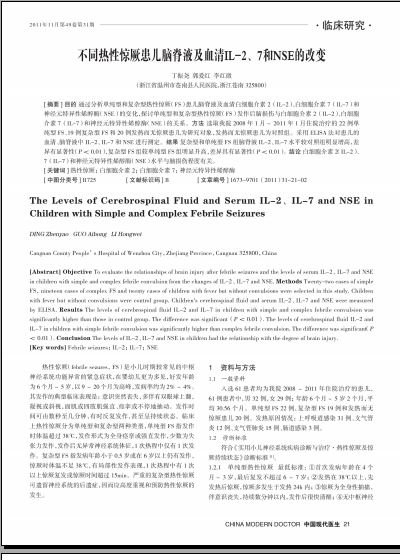不同热性惊厥患儿脑脊液及血清IL-2、7和NSE的改变(1)
 |
| 第1页 |
参见附件(2811KB,3页)。
[摘要] 目的 通过分析单纯型和复杂型热性惊厥(FS)患儿脑脊液及血清白细胞介素2(IL-2)、白细胞介素7(IL-7)和神经元特异性烯醇酶(NSE)的变化,探讨单纯型和复杂型热性惊厥(FS)发作后脑损伤与白细胞介素2(IL-2)、白细胞介素7(IL-7)和神经元特异性烯醇酶(NSE)的关系。方法 选取我院2008年1月~2011年1月住院治疗的22例单纯型FS、19例复杂型FS和20例发热而无惊厥患儿为研究对象,发热而无惊厥患儿为对照组。采用ELISA法对患儿的血清、脑脊液中IL-2、IL-7和NSE进行测定。结果 复杂型和单纯型FS组脑脊液IL-2、IL-7水平较对照组明显增高,差异有显著性(P<0.01),复杂型FS组较单纯型FS组明显升高,差异具有显著性(P<0.01)。结论 白细胞介素2(IL-2)、7(IL-7)和神经元特异性烯醇酶(NSE)水平与脑损伤程度有关。
[关键词] 热性惊厥;白细胞介素2;白细胞介素7;神经元特异性烯醇酶
[中图分类号] R725 [文献标识码] B [文章编号] 1673-9701(2011)31-21-02
The Levels of Cerebrospinal Fluid and Serum IL-2、IL-7 and NSE in Children with Simple and Complex Febrile Seizures
DING Zhenyao GUO Aihong LI Hongwei
Cangnan County People’s Hospital of Wenzhou City,Zhejiang Province,Cangnan 325800,China
[Abstract] Objective To evaluate the relationships of brain injury after febrile seizures and the levels of serum IL-2、IL-7 and NSE in children with simple and complex febrile convulsion from the changes of IL-2、IL-7 and NSE. Methods Twenty-two cases of simple FS,nineteen cases of complex FS and twenty cases of children with fever but without convulsions were selected in this study. Children with fever but without convulsions were control group. Children's cerebrospinal fluid and serum IL-2、IL-7 and NSE were measured by ELISA. Results The levels of cerebrospinal fluid IL-2 and IL-7 in children with simple and complex febrile convulsion was significantly higher than those in control group. The difference was significant(P<0.01). The levels of cerebrospinal fluid IL-2 and IL-7 in children with simple febrile convulsion was significantly higher than complex febrile convulsion. The difference was significant(P<0.01). Conclusion The levels of IL-2、IL-7 and NSE in children had the relationship with the degree of brain injury.
[Key words] Febrile seizures;IL-2;IL-7;NSE
热性惊厥(febrile sezures,FS)是小儿时期较常见的中枢神经系统功能异常的紧急症状,在婴幼儿更为多见,好发年龄为6个月~5岁,以9~20个月为高峰,发病率约为2%~4%。其发作的典型临床表现是:意识突然丧失,多伴有双眼球上翻,凝视或斜视,面肌或四肢肌强直、痉挛或不停地抽动。发作时间可由数秒至几分钟,有时反复发作,甚至呈持续状态。临床上热性惊厥分为单纯型和复杂型两种类型,单纯型FS指发作时体温超过38℃,发作形式为全身痉挛或强直发作,少数为失张力发作,发作后无异常神经系统体征,1次热程中仅有1次发作。复杂型FS指发病年龄小于0.5岁或在6岁以上仍有发作,惊厥时体温不足38℃,有局部性发作表现,1次热程中有1次以上惊厥复发或惊厥时间超过15min。严重的复杂型热性惊厥可遗留神经系统的后遗症,因而应高度重视和预防热性惊厥的发生。
1 资料与方法
1.1 一般资料
入选61患者均为我院2008~2011年住院治疗的患儿,61例患者中,男32例,女29例;年龄6个月~5岁2个月,平均30 ......
您现在查看是摘要介绍页,详见PDF附件(2811KB,3页)。